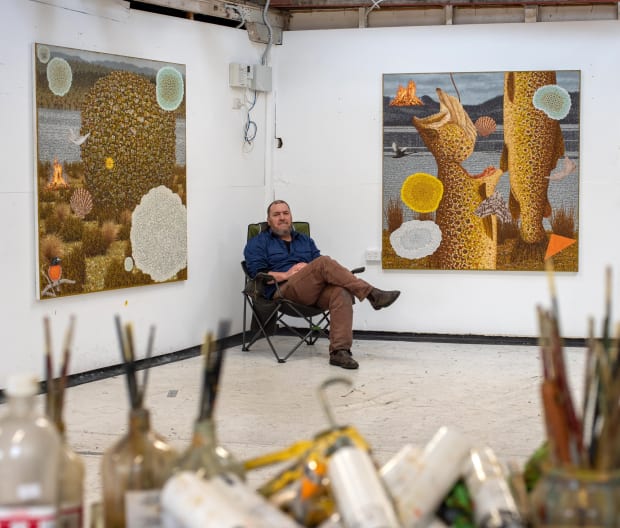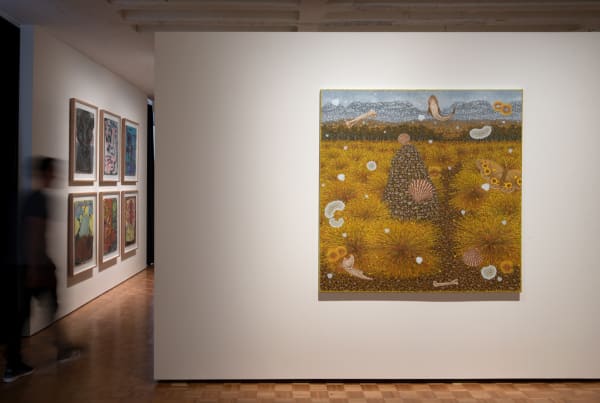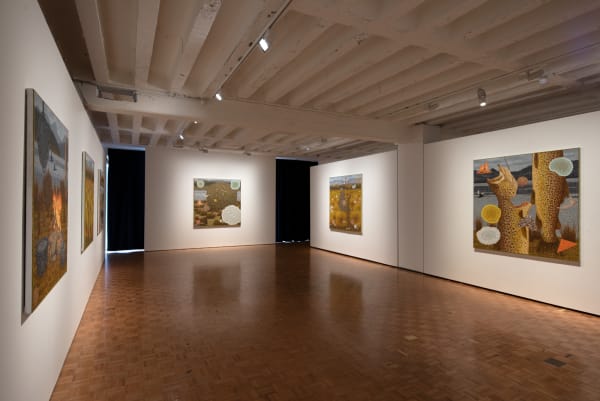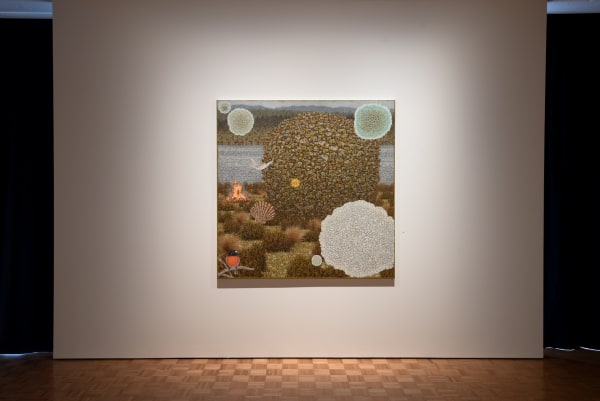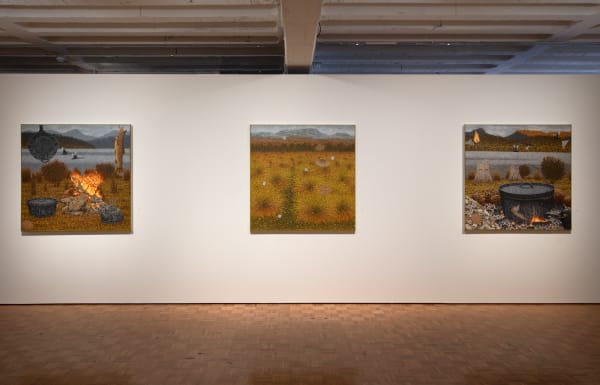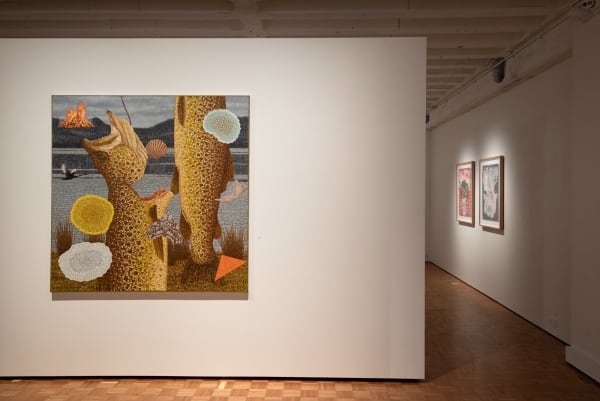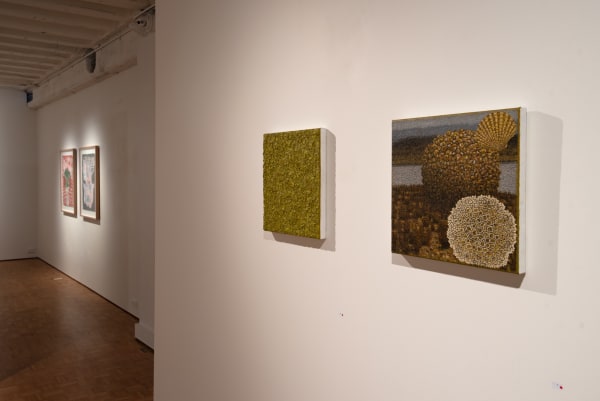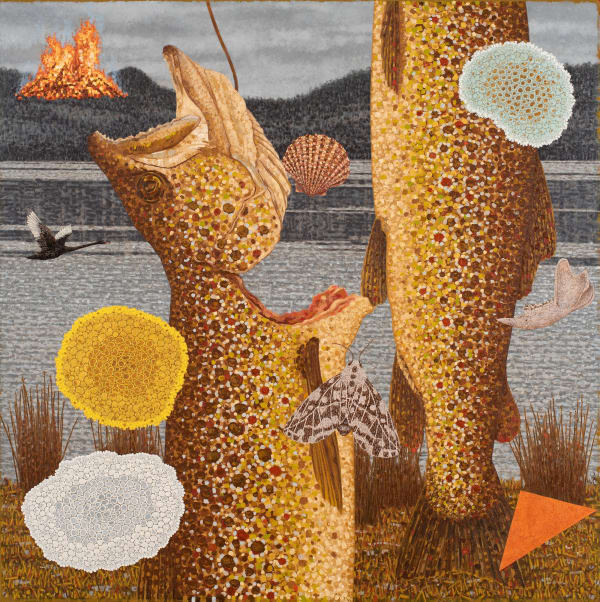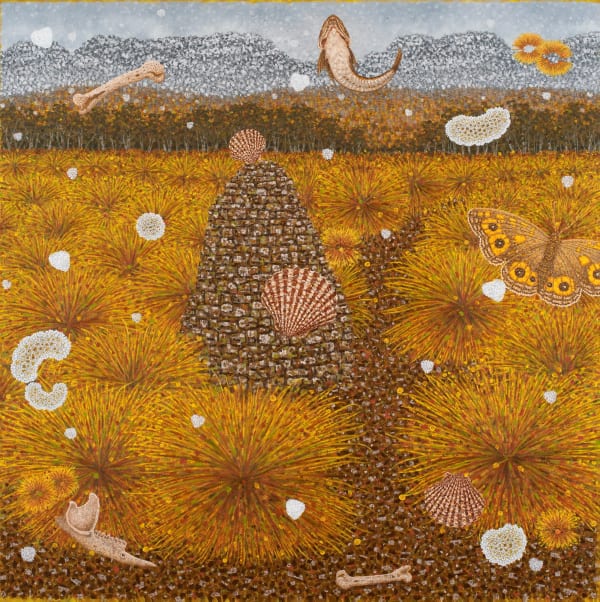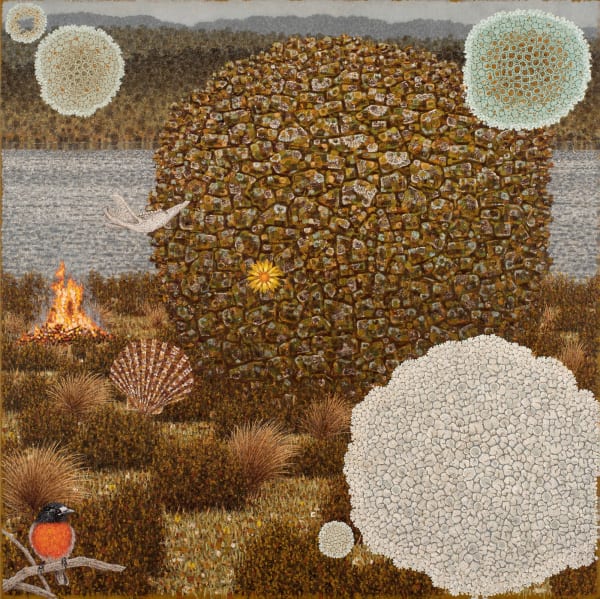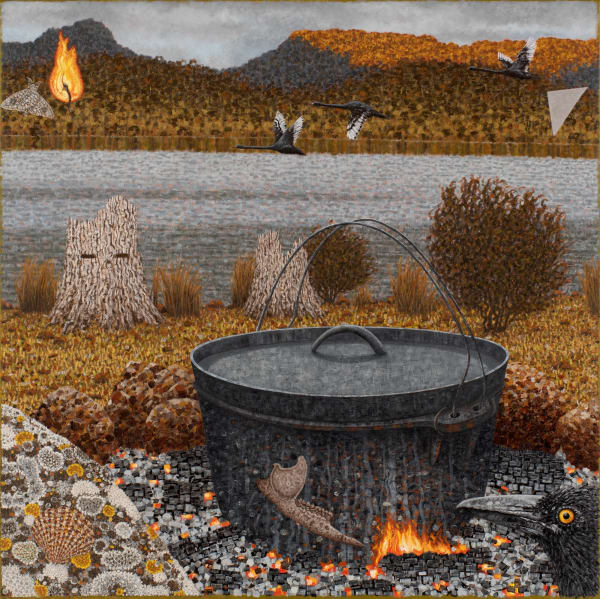-

-
Wastell places us where he has stood; we are irrevocably embedded in his reality, enveloped in his deep reverence for the bush
-
The title of this exhibition is ‘Preservations’. Something is being preserved here in these paintings, something precious and worth protecting. Something venerated. But what?
Many of the works in this exhibition contain depictions of scallop shells. They look a little out of place, appearing like dreams within these Tasmanian High Country landscapes and campsites. It might help to know that I grew up on the Tasmanian South East Coast. The humble scallop shell is one of the many washed up things that kicked around the backyard when I was a kid. They have come to represent where I am from.One of the earliest examples of prehistoric art is a stone hand-axe from Norfolk, England, probably several hundred thousand years old, the edge of which has been carefully knapped around the fossilised shell of a small bivalve mollusc. It looks like a tiny scallop shell but is actually a type of spiny oyster.Upon the Camino de Santiago, a pilgrimage route in northwestern Spain, the way is marked by scallop shells fixed to buildings along the road and pilgrims carry scallop shells upon their person as identifying symbols. The radial structure of the shell represents the many pilgrimage paths which converge upon a single point.It was my good fortune to grow up on the beaches of Tasmania’s South East Coast but my pilgrimage paths are to the Central Plateau Lake Country. This is the land I love the most, land which sustains me and that I wish to hold dear and share with others. Along with the daily practice of painting in the studio, these pilgrimages remain my preservations.Richard Wastell 2022 -
Richard Wastell’s enigmatic works render the Tasmanian landscape with such veracity that they are almost otherworldly. He has earned his reputation as a master of composition for large works, across multiple panels, in which elements of interest and admiration are pulled forward for artistic study. These magnified details—insects, shells, lichens, the patterned bark of tree trunks, the soft spines of a cushion plant—give Wastell’s works a uniquely exaggerated first-person perspective. The artist places us where he has stood; we are irrevocably embedded in his reality, enveloped in his deep reverence for the bush.
Perspective is as much a conceptual concern as it is a formal technique for the artist, whose love of painting is paralleled only by his love for the wilderness. The works are as complex and multifaceted as any act of looking, watching, witnessing. There is a deep and dark lament in the scorching of tree ferns after the clear-felling. There is burning joy in the sun that sets the grasslands ablaze at dusk. And there is a stillness and a deep satisfaction in the rippling lakes, the smouldering campfires and the fresh-caught trout in the falling darkness of late summer.
-
-
 Richard WastellReturn to Trout Lake, 2022oil and pumice on acrylic ground and linen153 x 153 cmSold
Richard WastellReturn to Trout Lake, 2022oil and pumice on acrylic ground and linen153 x 153 cmSold -
 Richard WastellInvincible Summer, 2022oil and pumice on acrylic ground and linen153 x 153 cmSold
Richard WastellInvincible Summer, 2022oil and pumice on acrylic ground and linen153 x 153 cmSold -
 Richard WastellThe Pilgrim, 2022oil and pumice on acrylic ground and linen153 x 153 cmSold
Richard WastellThe Pilgrim, 2022oil and pumice on acrylic ground and linen153 x 153 cmSold -
 Richard WastellThe hard road home, 2022oil and pumice on acrylic ground and linen122 x 122cmSold
Richard WastellThe hard road home, 2022oil and pumice on acrylic ground and linen122 x 122cmSold -
 Richard WastellPreservations, 2022oil and pumice on acrylic ground and linen122 x 122cmSold
Richard WastellPreservations, 2022oil and pumice on acrylic ground and linen122 x 122cmSold -
 Richard WastellSacred bones, 2022oil and pumice on acrylic ground and linen122 x 122cmSold
Richard WastellSacred bones, 2022oil and pumice on acrylic ground and linen122 x 122cmSold -
 Richard WastellSkittleballs Return, 2022oil and pumice on acrylic ground and linen41 x 41 cmSold
Richard WastellSkittleballs Return, 2022oil and pumice on acrylic ground and linen41 x 41 cmSold -
 Richard WastellLand of Moss and Lichen, 2022oil and pumice on acrylic ground and linen41 x 36 cmSold
Richard WastellLand of Moss and Lichen, 2022oil and pumice on acrylic ground and linen41 x 36 cmSold
-
-
Born in Hobart in 1974, Richard was awarded an honours degree in painting from the Tasmanian School of Art, University of Tasmania in 1996. He was the recipient of a three month Arts Tasmania Wilderness Residency at Cradle Mountain/Lake St. Clair National Park in 1997 and soon afterwards began exhibiting with Bett Gallery Hobart, where he continues to be represented today. Richard has held 13 solo exhibitions in Hobart, Melbourne and Sydney since 1998 and was commissioned by Devonport Regional Gallery to produce a solo exhibition in 2005.
Richard has been included in numerous group exhibitions throughout Australia, some of which have toured internationally. In 2013 Richard was one of ten artists invited to be part of ‘The Skullbone Experiment’ a touring exhibition and ABC documentary film arising out of an artist’s camp at Skullbone Plains, in Tasmania’s Central Highlands, hosted by the Tasmanian Land Conservancy. His work is held by many public and private collections in Australia including Parliament House, Canberra, Macquarie Bank, Tasmanian Museum and Art Gallery, Queen Victoria Museum and Art Gallery, Devonport Regional Gallery, Burnie Regional Gallery, Janet Holmes a Court Collection, RACV, Westmead Childrens Hospital and Artbank. Richard lives and works at Prince of Wales Bay, Derwent Park, Glenorchy, with artist Rosemary O’Rourke and their two children, James and Sarah.
